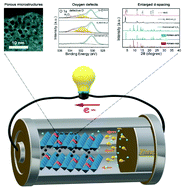Defected vanadium bronzes as superb cathodes in aqueous zinc-ion batteries†
Abstract
There is a growing need for fast, efficient, safe, and low-cost energy storage. Aqueous zinc-ion batteries (AZIBs) may be able to address this need, but suffer from fast capacity fade and poor ion diffusion kinetics due to unstable structures and non-optimised interspacing of layered cathode materials. Herein, we propose a structural engineering strategy by synergistically inducing anionic defects and cationic groups within vanadium bronze structures to improve kinetics and boost capacity. The materials discovered and used as the cathodes in AZIBs showed a high capacity of 435 mA h g−1 at a current density of 0.2 A g−1 and excellent stability with 95% capacity retention after 1500 cycles at 10 A g−1. This combined experimental and computational study systemically indicated that rapid Zn2+ storage was achieved from both a highly porous structure and enlarged d-spacing combined with improved electron conductivity as determined by density of states calculations. The modification of vanadium bronze-type cathodes achieved by controlled pre-intercalated species and tailored oxygen deficiency opens up an avenue for the realization of superior material design, whose feasibility is proved in this work.

- This article is part of the themed collections: Nanoscale Most Popular 2020 Articles and Celebrating 60 years of the Fujian Institute of Research on the Structure of Matter


 Please wait while we load your content...
Please wait while we load your content...